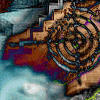
This CoverWeb pairs parallel OverViews by coordinators Anthony Rue and Jane Love, co-instructors of the NWE Practicum at UF. Because all the contributions that make up this CoverWeb elaborate individual inventions in response to a common teaching environment, Anthony's and Jane's introductions will focus on introducing the reader to this environment, the NWE. Anthony will be your guide to the history and design of the UCET writing project and its facilities, while Jane will chronicle the evolution of the NWE Practicum toward realizing the full pedagogical potential of both the NWE and the instructors participating in the project. Texts by Gregory Ulmer ("When in MOOville...") and John P. Leavey, Jr. ("Thrums") are linked from the OverViews and provide contrasting meditations on the pedagogical impact of the NWE on teaching at UF.
A central practice to emerge from teaching in the NWE focuses on questioning assumptions, particularly the assumption that confusion is necessarily bad and that a clear sense of "the lay of the land" is always good (see the excerpts from the contributors' MOOville dialog interspersed throughout the OverViews). Part of the epistemology of the NWE is in medias res: in the middle of things is an intimacy and immediacy of awareness and a consequent opportunity to forge creative and insightful perceptions and solutions. This CoverWeb's coordinators invite you to jump into it, in medias res.
Hypertextualizing Autobiography
Laura Sullivan
What happens to subjectivity in the electronic classroom? In this piece, I describe one pedagogical attempt to explore the issue. Fusing an examination of print autobiography with an investigation of hypertext as a form, the course I have developed centers around a challenging "problem": the invention and design of an electronic autobiography. The course, particularly through this final project hypertext, serves to encourage students to recognize their imbrication in the matrices of social forces.
Being In Pictures
Michelle Glaros
he says: Her point, you see, is to suggest that fanzines offer a method for writing with (rather than against) identification. In this context the star system reveals the social construction of the subject to the subject.
she says: that's beside the point.
he says: She wants to make a particular statement about form -- that the visual arts should be considered an organizational source for hypermedia writing. Consider the disappearing links. The effect of this technique is twofold: the disappearing link questions whether or not we can actually rid ourselves of cliches (or stereotypes). What is the effect of attempts to eradicate them? The language of the screens breaks down, becomes nonsensical, when these stereotypes are erased. In addition, the disappearing links provide a formal connection (a "techniqueal connection) to the zin/ographic experiment "Laying My Cards on the Table." Her point is not just to *talk* about writing experimentally, but to actually begin gesturing in that way.
she says: Pay no attention to the woman behind the screen.
Electronic Monumentality
Barry J. Mauer
Arguments preserve our memory, persuade people, and organize information. Monuments also serve these functions. Think of the Tomb of the Unknown Soldier. This monument reminds people of the sacrifices made by their predecessors, and thus it reminds people of their connection to a social body with a preferred set of values (the highest of which is to die for one's country -- and thus "live" forever). Monuments organize information: how much and what kind will be discussed throughout this web site.
Pedagogy is a practice of monumentality within education (involving the reading of cultural "touchstones") just as tourism is a practice of monumentality within leisure (Disney theme parks are part of national identity), but though the practices of monumentality developed over centuries of literacy and architecture have come under assault from electronic media, new practices of monumentality for the electronic have not yet been found. Finding, or inventing, these practices is the challenge we face.
Using MOOs as an Avenue of Critical Thought
Matthew McKinzie
The MOO had presented me with a problem, to wit: how can its narrative capacities be used to encourage students to examine texts more critically? The solution that I have used in "Using the MOO as an Avenue of Critical Thought" is to take two traditional (linear) written texts and to break them up into several MOO rooms each. The point of this exercise was to defamiliarize the two texts, and by doing so to make the weak points in their structures more prominent so that my freshman writing students could see the same problems in the texts that I saw. What I would want my students to do then would be to use the MOO on their own to break up another text in a similar way. To spatialize a bit of basic deconstructive work, then, was my goal.
Terrortories: The Uncharted Space of a Networked Writing Course
Rebecca Moss
Territory-- a field or sphere of action, thought, etc.; domain or province of something.
Terror--intense, sharp, overmastering fear. Feeling, instance, or cause of intense fear. Terror implies an intense fear which is somewhat prolonged and may refer to imagined or future dangers.
A Terrortory resists mapping; it is the nightmare landscape of the Cartesian.
This project crosses a few Terrortories -- Disorienting spaces for which conventional maps are inadequate:
Jazz and the Scene of Writing: 9 Variations on a Post-Theme
Michael A. Laffey
"Jazz and the Scene of Writing" gestures softly (as I fantasize it, this gesture resembles those of an actor in the Kabuki theater) toward the outlines of an approach to teaching basic freshman English composition. This approach might have been stated rather more succinctly (though surely less stylishly) with something like the following instructions:
